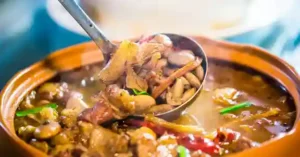Chicken noodle soup is a classic comfort food. But many store-bought versions are loaded with sodium. This low sodium chicken noodle soup recipe keeps the same warmth and flavor without the excess salt. It’s light, nourishing, and easy to make at home. Perfect for a cozy meal, meal prep, or a healthy option for the whole family. Let’s explore how to make it delicious and heart-friendly.

Why Choose Low Sodium Chicken Noodle Soup Recipe
Chicken noodle soup has always been the go-to comfort food. It’s warm, filling, and soothing for the body. But traditional recipes and canned soups often come with one major drawback — too much sodium. High sodium intake is linked to high blood pressure, heart problems, and water retention. For people managing hypertension or aiming for a healthier diet, reducing salt makes a big difference.
A low sodium chicken noodle soup recipe gives you all the comfort without the risks. By lowering the salt and using fresh herbs, vegetables, and lean chicken, you create a nourishing bowl that supports heart health. It’s especially helpful for:
- People with high blood pressure who need to watch daily sodium intake.
- Anyone on a heart-healthy diet recommended by doctors or dietitians.
- Families who want a lighter, healthier homemade option instead of canned soups.
- Health-conscious eaters who prefer clean, wholesome meals.

Key Ingredients and Low-Sodium Swaps
The secret to a flavorful low sodium chicken noodle soup is choosing the right ingredients and making smart swaps. You don’t need loads of salt to bring out great taste — fresh produce, herbs, and lean protein do the work for you. Here’s what goes into the recipe:
Chicken
Use skinless, boneless chicken breast or thighs for lean protein. Thighs give more flavor, while breasts keep it light. Poaching the chicken in the soup base adds richness without sodium.
Vegetables
Classic choices include carrots, celery, onions, and garlic. Add zucchini, peas, or spinach for extra nutrition and color. Fresh or frozen veggies work fine — just avoid canned vegetables since they often contain added salt.
Broth or Stock
This is the biggest source of sodium in traditional chicken noodle soup. Use low-sodium chicken broth or make homemade stock to control the salt. If using store-bought, look for cartons labeled “low sodium” or “no salt added.”
Noodles
Egg noodles are traditional, but you can use whole wheat pasta, brown rice noodles, or gluten-free noodles for a healthier twist. Cook them separately if you plan to store or freeze the soup so they don’t get mushy.
Herbs and Spices
Fresh parsley, thyme, and dill bring out flavor without needing salt. Bay leaves, black pepper, turmeric, and paprika also add depth. A splash of lemon juice at the end brightens the soup naturally.
Low-Sodium Flavor Enhancers
Instead of salt, use garlic powder, onion powder, or nutritional yeast for umami flavor. A dash of olive oil or a sprinkle of parmesan (optional) can give richness without overwhelming sodium.

Choosing the Right Noodles and Broth
The backbone of any chicken noodle soup is the broth and the noodles. Since we’re keeping sodium low, choosing wisely here makes all the difference.
The Broth or Stock
- Homemade Stock: The best option for full control over ingredients. Simmer chicken bones, onions, carrots, celery, garlic, and herbs in water. Strain and use as your base — rich in flavor, naturally low in sodium.
- Low-Sodium Store-Bought Broth: When short on time, use cartons labeled “low sodium” or “no salt added.” These typically contain 70–140 mg of sodium per cup compared to 800+ mg in regular broth.
- Flavor Boosting Without Salt: Add bay leaves, thyme, parsley stems, peppercorns, or a splash of lemon juice to deepen the flavor of your broth.
The Noodles
- Traditional Egg Noodles: Soft and comforting, these are the classic choice. They absorb broth well but can get mushy if overcooked.
- Whole Wheat Noodles: A healthier alternative with more fiber and nutrients.
- Gluten-Free Options: Brown rice noodles, chickpea pasta, or quinoa pasta work well for those avoiding gluten.
- Cooking Tip: To prevent soggy noodles, cook them separately and add just before serving. This also helps if you plan to store or freeze the soup.
Balancing Both Together
A flavorful low sodium broth paired with the right type of noodles creates the heart of the recipe. Keep the noodles light and the broth rich in natural flavors from herbs and vegetables. Together, they make a comforting bowl that’s both healthy and satisfying.

Step-by-Step Cooking Instructions
Making low sodium chicken noodle soup at home is simple and rewarding. Follow these steps for a flavorful, heart-healthy soup:
Prepare the Chicken
Rinse and pat dry skinless, boneless chicken breasts or thighs. Cut into medium chunks, or leave whole if you prefer to shred after cooking.
Sauté the Vegetables
Heat a small amount of olive oil in a large soup pot. Add onion, celery, carrot, and garlic. Cook for 4–5 minutes until softened and fragrant. This builds the flavor base without the need for extra salt.
Build the Broth
Pour in low-sodium chicken broth or homemade stock. Add the chicken pieces directly into the pot. Season with bay leaves, thyme, black pepper, and fresh parsley stems. Simmer gently for 20–25 minutes until the chicken is fully cooked.
Remove and Shred Chicken
Take out the chicken and shred it with two forks. Return the shredded meat to the pot for even distribution.
Cook the Noodles
In a separate pot, boil noodles until just tender (al dente). Drain and set aside. This prevents sogginess when storing leftovers.
Combine and Adjust
Add the noodles into the soup just before serving. Taste and adjust flavor with herbs, garlic powder, onion powder, or a splash of lemon juice instead of salt.
Serve Hot
Garnish with fresh parsley or dill. Enjoy a comforting bowl that’s hearty, flavorful, and low in sodium.

Flavor Boosters Without the Salt
One of the biggest challenges in low sodium cooking is keeping the dish flavorful. Luckily, chicken noodle soup offers endless opportunities to add depth without reaching for the salt shaker. Here’s how to build bold flavor naturally:
Fresh Herbs
Parsley, dill, thyme, rosemary, and cilantro bring freshness and aroma. Add hardy herbs like thyme early in cooking, and sprinkle soft herbs like parsley or dill at the end for brightness.
Garlic and Onion
These two create the foundation of flavor. Sautéing them first releases natural sweetness and richness, making the soup savory without extra sodium.
Spices
Black pepper, paprika, turmeric, or a pinch of cayenne enhance taste without salt. Turmeric not only gives color but also adds anti-inflammatory benefits.
Acid for Balance
A splash of fresh lemon juice or a few drops of apple cider vinegar brightens the soup and makes the flavors pop. Acid balances the broth in the same way salt does, but without adding sodium.
Umami-Rich Additions
Try a pinch of nutritional yeast, which gives a cheesy, savory note. A spoonful of tomato paste adds depth and natural sweetness.
Vegetables for Natural Sweetness
Carrots, celery, and onions release sugars as they cook, making the broth rich and layered. Adding zucchini or sweet corn can boost flavor while keeping it wholesome.

Tips for Success and Variations
A great low sodium chicken noodle soup comes down to smart techniques and flexible options. These tips will help you make the most flavorful, healthy bowl every time.
Tips for Success
Use Fresh Ingredients
Fresh vegetables and herbs add more flavor than canned or dried versions.
Cook Noodles Separately
Keeps them firm and prevents them from soaking up all the broth when storing leftovers.
Don’t Rush the Simmer
Letting the soup simmer slowly helps flavors blend naturally without added salt.
Taste as You Go
Adjust flavor with herbs, spices, or a splash of lemon juice instead of salt.
Shred Chicken After Cooking
Cooking it whole keeps it juicy, and shredding after simmering makes the meat more tender.
Variations to Try
- Vegetable-Loaded Version: Add spinach, kale, zucchini, or peas for extra nutrients.
- Whole Grain Twist: Swap egg noodles with whole wheat pasta or brown rice noodles for added fiber.
- Gluten-Free Option: Use quinoa pasta, rice noodles, or chickpea pasta.
- Instant Pot Method: Cook everything in one pot for a quick, hands-off meal.
- Spicy Kick: Add red pepper flakes or a small pinch of cayenne for gentle heat.
- Mediterranean Style: Add lemon zest, oregano, and a drizzle of olive oil for a fresh twist.

Storage, Reheating, and Freezing Guide
Low sodium chicken noodle soup is perfect for making ahead. With the right storage methods, you can enjoy a fresh-tasting bowl anytime.
Storing in the Refrigerator
Allow the soup to cool completely before storing. Keep it in an airtight container in the fridge for up to 3–4 days. For best results, store noodles separately from the broth to prevent them from becoming mushy.
Reheating
Warm the broth and chicken mixture on the stovetop over medium heat until hot. If you stored noodles separately, add them just before serving. For microwave reheating, heat in short intervals and stir to distribute heat evenly.
Freezing for Later
Chicken noodle soup freezes well, but noodles often break down in the freezer. Freeze the soup without noodles; cook fresh pasta when reheating. Portion the soup into freezer-safe containers or bags for easy single servings. Label with the date — it will stay fresh for up to 3 months.
Thawing and Serving
Thaw overnight in the refrigerator, then reheat on the stove. Add freshly cooked noodles before serving for the best texture.

Serving Suggestions
Low sodium chicken noodle soup is satisfying on its own, but pairing it with the right sides and garnishes makes it even more enjoyable. Here are some simple and healthy ways to serve it:
Bread and Crackers
Whole grain bread or a slice of crusty baguette complements the soup beautifully. Try unsalted crackers for a light and crunchy side.
Light Salads
A mixed green salad with olive oil and lemon dressing adds freshness. A cucumber and tomato salad balances the warmth of the soup with something crisp and cool.
Garnishes for Extra Flavor
Sprinkle with fresh parsley, dill, or cilantro for color and brightness. Add a squeeze of lemon juice just before serving for a zesty finish. A light sprinkle of black pepper or paprika adds warmth without sodium.
Family-Friendly Pairings
Serve with roasted vegetables for a heartier meal. Pair with a grilled cheese sandwich made with low-sodium cheese for a comforting combo.
Beverage Pairings
A glass of sparkling water with lemon keeps the meal light. For a cozy pairing, try herbal tea like chamomile or mint alongside the soup.

Nutrition Facts and Health Insights
Low sodium chicken noodle soup isn’t just comforting — it’s also a smart choice for heart health and overall wellness. By controlling the ingredients, you can enjoy a soup that’s nourishing and flavorful without excess salt.
Sample Nutrition (per 1 serving, about 1 ½ cups)
- Calories: ~220
- Protein: 20–25 g
- Carbohydrates: 20–25 g
- Fiber: 3–4 g
- Fat: 6–8 g
- Sodium: 120–180 mg (varies depending on broth and noodles used)
(Note: Values are approximate and will vary based on ingredient choices and portion sizes.)
Health Insights
Low Sodium Benefits
Helps maintain healthy blood pressure and reduces strain on the heart. Supports kidney health by lowering the workload of filtering excess salt.
High in Protein
Lean chicken provides protein for muscle repair and satiety.
Rich in Nutrients
Vegetables like carrots, celery, and onions add vitamins, minerals, and fiber. Whole grain or vegetable-based noodles can boost fiber further.
Balanced Meal
Combines protein, complex carbs, and vegetables in one bowl. Can be customized to fit gluten-free, low-fat, or high-fiber diets.
Dietitian-Approved Comfort Food
Unlike canned soups that often contain 700–900 mg sodium per cup, this homemade version cuts that by more than half without losing flavor.
Conclusion
In the end, this low sodium chicken noodle soup recipe gives you the comfort of a classic dish with a healthier twist. By using fresh ingredients, flavorful herbs, and smart swaps, you get all the warmth and nourishment of traditional chicken noodle soup without the excess salt. It’s simple to make, easy to adapt, and good for the whole family. A bowl of this soup is more than just a meal — it’s a heart-healthy comfort food you can feel good about serving again and again.
FAQS

Low Sodium Chicken Noodle Soup Recipe
Ingredients
Method
- Add butter, diced celery and carrots to a large stock pot over medium-high heat. Saute for 3 minutes. Add garlic and cook for another 30 seconds.
- Add chicken stock and season the broth with rosemary, thyme, crushed red pepper, and salt (definitely TASTE the broth before adding more salt), and pepper. Taste and add a spoonful of “better than bullion” chicken or chicken bouillon cubes or granules as needed.
- Bring broth to a boil. Add noodles (either uncooked homemade egg noodles, or dry store-bought pasta) and cook just until noodles are al dente.
- If using store-bought noodles, be cautious not to overcook them! Remove pot from heat as soon as they are just barely tender. The noodles will continue to cook once you remove the pot from the heat, and you don’t want them mushy.
- Add chicken meat from the rotisserie chicken. Taste the broth again and add more seasonings, if needed.
- Store leftovers in an airtight container in the refrigerator for 4-5 days, depending on the freshness of the chicken you used.
